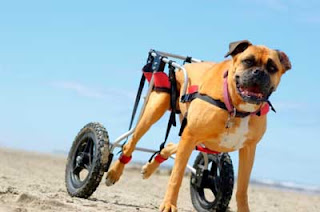What Arthritis Is?
 Your dog’s skeletal system is a marvelous framework of bones, ligaments and cartilage all working together. The joints provide the flexibility needed for different movements such as running, jumping, walking and climbing, among many others. Sometimes, however, things go wrong with the joints and movement is painful and impaired. Arthritis can develop when a joint sustains damage, whether it’s caused by physical trauma (such as an injury) or disease. Once this occurs, a dog’s ordinary movements become much more difficult and painful.
Your dog’s skeletal system is a marvelous framework of bones, ligaments and cartilage all working together. The joints provide the flexibility needed for different movements such as running, jumping, walking and climbing, among many others. Sometimes, however, things go wrong with the joints and movement is painful and impaired. Arthritis can develop when a joint sustains damage, whether it’s caused by physical trauma (such as an injury) or disease. Once this occurs, a dog’s ordinary movements become much more difficult and painful.Arthritis is caused by inflammation in a joint. The condition is categorized by the source of this inflammation. There are two main types of arthritis – degenerative (osteoarthritis) and inflammatory.
 Osteoarthritis (sometimes called degenerative joint disease) is by far the most common type of canine arthritis. This type of arthritis develops over time and is often caused by injury to a joint which eventually damages or destroys the cartilage that protects the bones.
Osteoarthritis (sometimes called degenerative joint disease) is by far the most common type of canine arthritis. This type of arthritis develops over time and is often caused by injury to a joint which eventually damages or destroys the cartilage that protects the bones.In addition to injury, excessive jumping, excessive weight or even just the aging process can cause cartilage destruction and eventually lead to arthritis. Hip dysplasia and patella luxation (“loose” kneecaps) can also cause the type of joint degeneration that causes arthritis.
 Inflammatory arthritis (sometimes called inflammatory joint disease) is the other main type of arthritis, but it is far less common. It can be caused by an infection (such as Rocky Mountain spotted fever or a bacterial infection) or an underlying immune disorder such as lupus erythematosus. This form of arthritis typically affects more than one joint and is associated with overall stiffness, fever and loss of appetite. Rheumatoid arthritis can also occur in dogs, although it is rare.
Inflammatory arthritis (sometimes called inflammatory joint disease) is the other main type of arthritis, but it is far less common. It can be caused by an infection (such as Rocky Mountain spotted fever or a bacterial infection) or an underlying immune disorder such as lupus erythematosus. This form of arthritis typically affects more than one joint and is associated with overall stiffness, fever and loss of appetite. Rheumatoid arthritis can also occur in dogs, although it is rare.Age and Breed Susceptibility
 Although it’s true that younger dogs can develop arthritis, older dogs are much more prone to the condition. In young dogs the cause is likely to be an injury, but in older or overweight dogs, it is more likely to be caused by simple wear and tear. Some breeds are more susceptible to arthritis than others, although it can occur in any dog. As a general rule, larger breeds such as Labrador Retrievers, Collies, Rottweilers and German Shepherds are at higher risk.
Although it’s true that younger dogs can develop arthritis, older dogs are much more prone to the condition. In young dogs the cause is likely to be an injury, but in older or overweight dogs, it is more likely to be caused by simple wear and tear. Some breeds are more susceptible to arthritis than others, although it can occur in any dog. As a general rule, larger breeds such as Labrador Retrievers, Collies, Rottweilers and German Shepherds are at higher risk.Dogs and Arthritis: The Symptoms
 Your dog might be stiff or lame after exercise or a long nap, or he might be reluctant to climb up or down stairs. Don’t automatically assume he has arthritis, however. Although these symptoms could be signs of arthritis, they might instead be the result of some other health condition. Instead of making assumptions, take your dog to the vet for evaluation and appropriate treatment. As a general rule, however, dogs with arthritis will exhibit one or more of the following symptoms:
Your dog might be stiff or lame after exercise or a long nap, or he might be reluctant to climb up or down stairs. Don’t automatically assume he has arthritis, however. Although these symptoms could be signs of arthritis, they might instead be the result of some other health condition. Instead of making assumptions, take your dog to the vet for evaluation and appropriate treatment. As a general rule, however, dogs with arthritis will exhibit one or more of the following symptoms:* Limping or walking very slowly
* A reluctance to go on walks, climb up or down stairs, run, jump or play
* Yelping in pain when touched, or resisting being touched
* Slowness or visible difficulty when rising from a lying or sitting position
In addition, dogs with chronic arthritis might become aggressive, depressed, nervous or lethargic.
Dogs and Arthritis: Treatment and Therapies
 When it comes to dogs and arthritis, early diagnosis and good management of the condition are the keys, because arthritis cannot be completely cured. As a result, arthritis treatments and therapies are intended to reduce the symptoms and make arthritic dogs more comfortable.
When it comes to dogs and arthritis, early diagnosis and good management of the condition are the keys, because arthritis cannot be completely cured. As a result, arthritis treatments and therapies are intended to reduce the symptoms and make arthritic dogs more comfortable.Gentle, low-stress exercise and moderate quantities of nutritious, healthy food can help control an arthritic dog’s weight and thereby reduce weight-induced stress on arthritic joints. Leading an active lifestyle will also ensure that a dog’s joints are kept in motion and cause less pain. Dogs should be taken on a daily walk to keep them as mobile as possible.
 Anti-inflammatory medications such as NSAIDs can be used to help alleviate the pain, inflammation, swelling and stiffness associated with arthritis. Analgesics such as aspirin or acetaminophen can also encourage movement by helping to overcome the pain. When the arthritis is causing extreme pain, cortisone injected directly into the joint can result in almost immediate relief.
Anti-inflammatory medications such as NSAIDs can be used to help alleviate the pain, inflammation, swelling and stiffness associated with arthritis. Analgesics such as aspirin or acetaminophen can also encourage movement by helping to overcome the pain. When the arthritis is causing extreme pain, cortisone injected directly into the joint can result in almost immediate relief.A large number of joint health supplements are also available when you’re dealing with dogs and arthritis. Most contain glucosamine and chondroitin, although some include additional ingredients such as specific vitamins and minerals. Finally, you can also help by giving your dog a soft comfy place to sleep, such as a thick foam rubber cushion. Dogs and arthritis are a painful combination, but there are some things you can do to help.
There's nothing more than help with this Arthritis in Dogs Information, we just wanted to share and help in case some people really needed it, people who reads this blog especially.

No comments:
Post a Comment